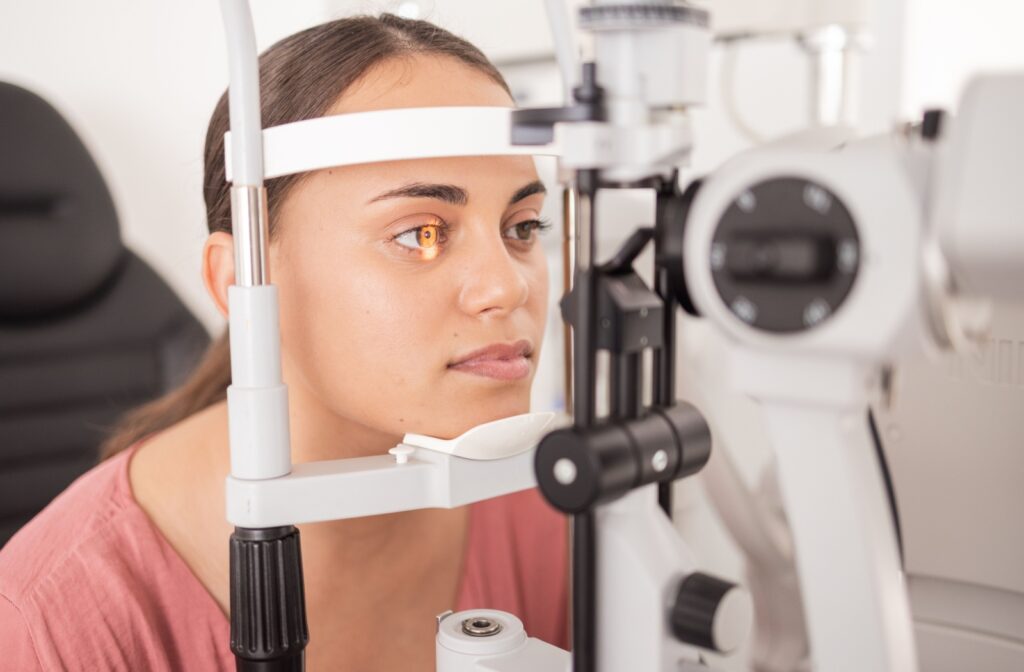In the hustle and bustle of daily life, clear vision is something we often take for granted. Whether it’s spotting a friend across the park, driving, or enjoying a movie, our ability to see clearly from afar directly impacts our quality of life. But when things get blurry, you may start to wonder about glasses—or more specifically, what kind of glasses you need.
The strength of the glasses you need for distance will depend on your prescription. Your optometrist determines your prescription with a series of tests performed during an eye exam. It’s a precise process and you should come out the other end with glasses made especially for you.
Understanding Vision & Glasses
To kick things off, it’s vital to understand how our eyes work in relation to distance vision. Our eyes focus light rays to form an image on the retina. When this process doesn’t go exactly right—typically due to the shape of the eye—-we experience vision problems.
Common culprits include:
- Nearsightedness (myopia), where distant objects appear blurry
- Farsightedness (hyperopia), which makes close objects more difficult to see clearly
- Astigmatism, affecting overall vision.
Each of these conditions means the eye isn’t focusing light directly on the retina, and glasses are prescribed to adjust this focus. If you or a family member is having trouble with distance vision specifically, it’s likely you’re dealing with myopia.
What is Myopia?
If you’re at a concert and can’t clearly see the band members’ faces from a distance, you might have myopia. This condition means your eyes are better at seeing things up close than far away and it’s usually due to your eye’s shape. This irregular shape can happen in two ways:
- The eye has grown too long
- The cornea is too curved
These can cause light to focus in front of the retina instead of directly on it, resulting in blurred distance vision. Myopia is strikingly common, with some experts predicting that 50% of the world’s population will have some level of myopia by 2050.
The Role of an Optometrist
Using a series of tests, an optometrist can measure your sight and examine your overall eye health. This data allows them to determine the exact prescription needed to correct your distance vision. It’s an art and a science, dedicated to getting you the clarity you need for those far-off details.
So how does an optometrist figure out your prescription? It’s like making a tailored suit for your eyes—it’s all about the measurements. They typically use a refraction test. During this, you’ll look through a device called a phoropter and read letters or images from a chart. Meanwhile, they can flip through a series of lenses so you can tell them which one helps you see better.
Optometrists can also use a computerized test to measure how light bounces off your retina directly. By watching how light moves within your eye, they can get an idea of your prescription. Based on these tests, they’ll mix and match until they find the golden ticket to clear vision for you. It can seem like magic, but it’s simply professionals performing highly precise science

What the Numbers on Your Prescription Mean
If you’ve ever glanced at your prescription and felt like you were looking at a secret code, you’re not alone. They’re a collection of numbers and letters that act as shorthand for anyone manufacturing your lenses.
The first numbers you’ll see are often labeled SPH, which means sphere. This is the core of the lenses and indicates what strength you need to correct your vision. If you’re having problems with distance, you’ll probably also see DV, standing for distance vision.
The number that follows is the specific lens power. A minus sign (-) means you’re nearsighted, and a plus sign (+) is for farsightedness. Eyeglass strength is measured in diopters.
If your prescription reads -2.00, it means you’re nearsighted and you require 2 diopters of strength to correct your vision. Since the minus or plus sign simply indicates if you’re near or farsighted, the higher the number always means you need more correction to see clearly. -5.00 is higher than -2.00, for instance.
Types of Glasses for Different Visions
There are glasses for just about everything! For those who need help up close, reading glasses are the way to go. These lenses are specifically designed for seeing things right in front of you, like books or screens.
Then, there are bifocals and progressives, the multitaskers of the glasses world. Bifocals are like having two glasses in one—one part for distance and another for reading. Progressives take it up a notch, offering a smooth, gradual transition between multiple lens powers for near, intermediate, and distance vision.
The trick is finding the right fit for your lifestyle and vision needs!
Finding Your Perfect Glasses
Finding the right strength for your distance glasses might seem daunting, but it’s a key step towards clearer vision. Remember, accurate glasses can not only improve your day-to-day life but also protect your overall eye health.
If you’ve been squinting at signs or missing out on distant details, it’s time to book an eye exam with Total Vision Pasadena. Clearer, more vibrant vision could be just an appointment away. So, don’t hesitate to take care of your eyes and get the right strength glasses for distance today!




